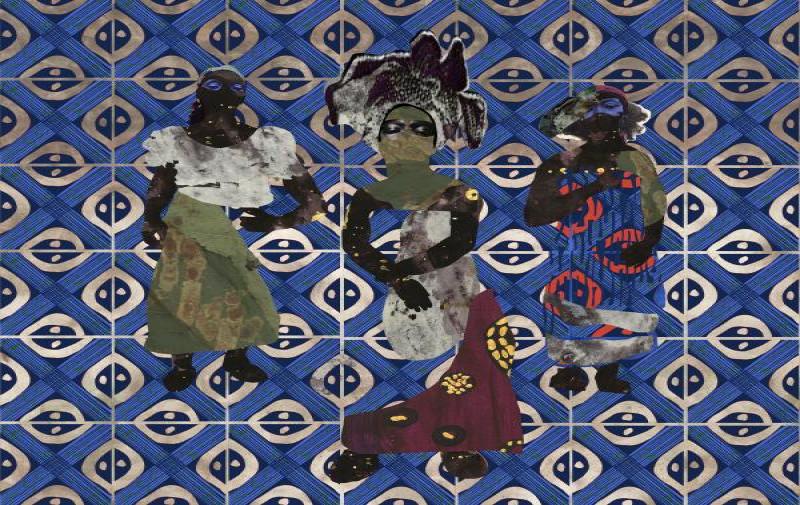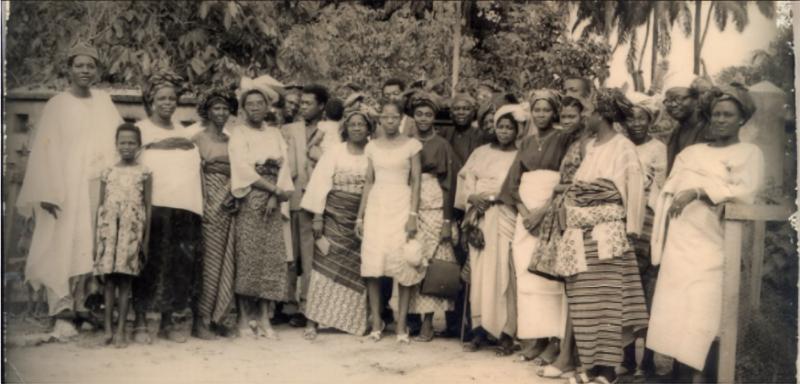This year’s Black History Month celebrates resilience, strength, and the unshakable drive for progress within the Black community worldwide. In that spirit, I want to spotlight a project that embodies all three: Leaders of Resistance. It pays homage to the roaring strength, leadership, activism, and power of the Abeokuta Women’s (1946) Revolt in Nigeria. Reminding us of a truth history often overlooks; women can be found at the centre of any form of resistance against colonial forces.

Leaders of resistance, Mixed Media, 500 x 594 mm, 2022
Our Story: Africa’s Climate
In 2022 I was commissioned by the Africa Centre to create a piece of art for Our Story: Africa’s Climate, a group exhibition of emerging African artists. The show aimed to highlight the impact of the climate emergency in Africa and diversify the conversation around climate change by centering African voices.
When I was approached by the curator Haja Fanta I began to think about the collective need for healing. As a society we are suffering from the trauma of loss and violence, climate change is having a physical and direct effect on our health and wellbeing. It is also affecting our minds, there is an urgent need to decolonise how we view nature and question what we have been taught about the environment, history and our current socio-political crisis. Climate injustice is an intersectional matter which disproportionately affects Black, Brown and marginalised communities. It was this driving factor that led to my research into environmental colonialism and the long lasting effects it has on Nigeria.
The Pollution of Violence
The Pollution of Violence was a core theme I kept on referring back to; the phrase refers to the way colonial violence has destroyed and polluted the land, spirit and bodies of African people. This act of eco-fascism allows for and justifies the use of oppressive forces such as dehuminisation, white-supremacy, patriarchy, classism, racism and capitalism against marginalised and indigenous communities. I wanted to challenge the way it negates any responsibility and accountability by creating an artwork that showcases the resilience of Nigerian communities and the ways they have fought against British colonial forces.
This desire took me on an investigative and creative journey of activism, climate action and cultural pride where I learnt about the Abeokuta Women’s Revolt (1946).
Abeokuta Women’s Revolt
In 1946 an uprising began in Abeokuta when the market women objected to unfair and excessive taxation on women and the failure of their governing rulers to address the injustice. The methods of tax collection were degrading and violent. “Homes were invaded and women were sometimes physically assaulted, including being stripped naked on the pretext of assessing their ages to determine eligibility for taxation.” Many women were imprisoned if they did not pay their taxes or fined.
The economic and agricultural landscape was harsh and hostile following the Second World War, with many Nigerians experiencing food shortages and insecurity. This was heightened when the colonial government issued a food price control scheme and prioritised military demand. This new scheme greatly affected women as they were the main traders and producers of food. From 1918 women were expected to pay taxes from the age of 15 which now included income tax, water rates, money for market supervisors and a flat tax rate. What was happening was a key example of how environmental colonialism tried to use food insecurity, violence, and misogyny to commodify and reframe indigenous relationships with agriculture and trade.
After years of tirelessly fighting against these oppressive conditions the demands of the women of Abeokuta were met in 1949. All the hard work and bravery had paid off, they formed unions such as the Abeokuta Women’s Union (AWU), sent out multiple petitions, conducted marches and carried out various forms of community organising. One of the most notable being the mass demonstration and protest in November 1947 which involved more than 10,000 women.
Now if this doesn't scream Standing Firm in Power and Pride, then I don’t know what does.

Abeokuta Women’s Union. [Women in African History: an E-Learning Tool; CC-BY-SA UNESCO.]
Standing Firm in Power and Pride
As soon as I finished learning about this radical anti-colonial feminist moment in history I immediately phoned my Grandma to ask her about it. She shared that her mother was born in Abeokuta and had told her stories about the women in her village protesting. Hearing about the connection my Great-Grandmother had to this revolutionary act of resistance was the cherry on top, everything was aligning. I had to make sure the legacy of these brave women lived on. Their commitment to justice and freedom deserved to be celebrated and heard, and I was determined to let them speak through my work, and so Leaders of resistance was born.
The project affirms a vital truth: women have always been at the heart of resistance, embodying the pride, power, and resilience that sustain Black communities in the face of colonial and systemic oppression. By re-centering their stories, Leaders of resistance contributes to the legacy of empowerment and unity that this year’s Black History Month theme so powerfully celebrates.
Learn more about Chioma Ince and her work here
